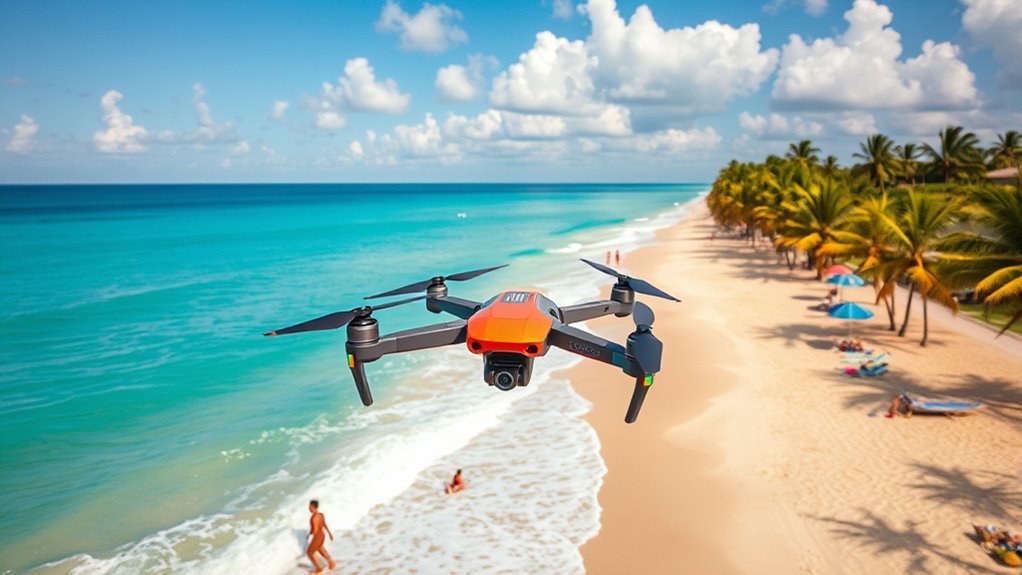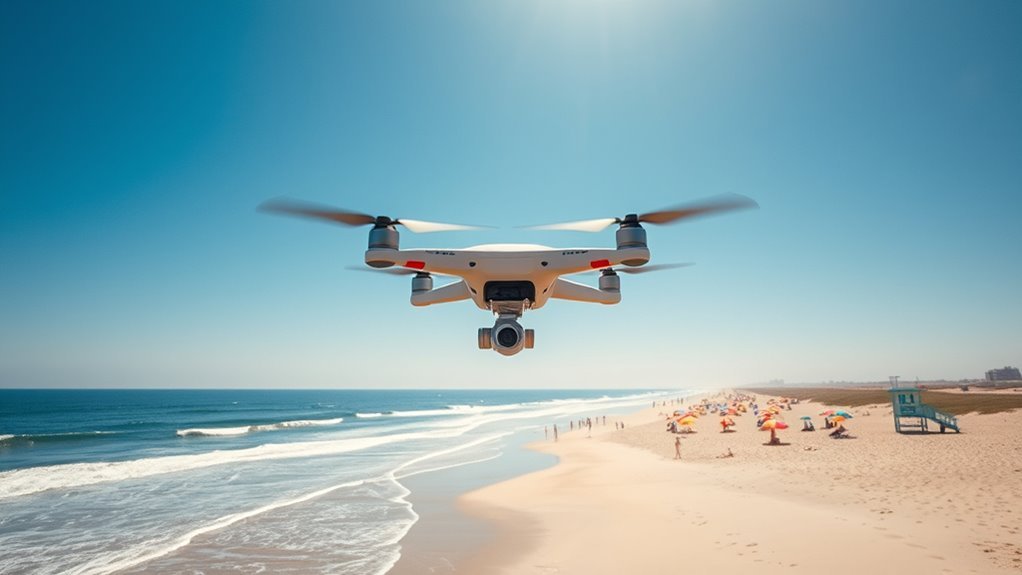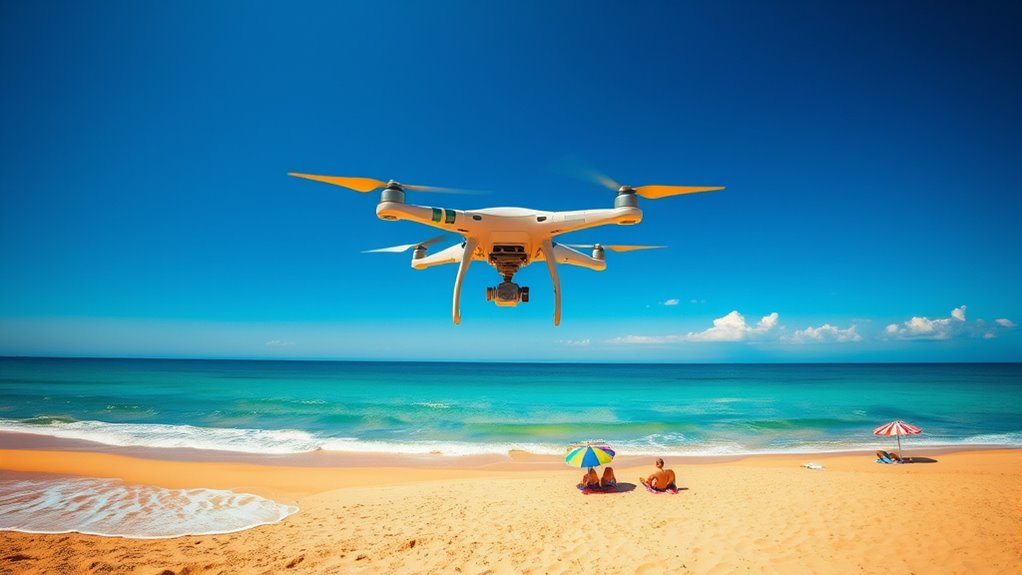To legally fly a drone on the beach, you need to comply with FAA regulations and local laws. Make certain your drone is registered if it weighs over 0.55 pounds, maintain a visual line of sight, and avoid no-fly zones. Plus, be mindful of wildlife and beachgoers. It’s crucial to respect local ordinances. By following these guidelines, you’ll guarantee a safe experience for everyone involved. There’s more important information to explore to enhance your flying adventures.
Understanding FAA Regulations for Drone Flight

Before you take your drone to the beach, it’s essential to understand the FAA regulations governing drone flight. First, verify your drone is registered if it weighs over 0.55 pounds. This registration not only legitimizes your flight but also enhances safety. When flying, you must adhere to a maximum flight altitude of 400 feet to avoid interfering with manned aircraft. Additionally, you should always keep your drone within your visual line of sight. Familiarize yourself with these regulations to enjoy your flying experience while respecting the airspace. Remember, adhering to FAA guidelines not only verifies your freedom to fly but also protects the safety of others, allowing you to capture breathtaking beach moments without worry.
Local Laws and Beach-Specific Regulations

While understanding FAA regulations is essential, you can’t overlook local laws and beach-specific regulations that may affect your drone flying experience. Many beaches have specific regulations that dictate where and when you can fly your drone. Local ordinances might restrict drone use during peak hours, on certain days, or even prohibit it altogether in some areas. It’s vital to check with local authorities or the beach management for guidelines to avoid fines or confiscation. Be aware of any posted signs indicating drone restrictions, and always respect the privacy of others enjoying the beach. By staying informed about beach regulations, you can guarantee your drone flying remains an enjoyable and lawful activity.
No-Fly Zones: What You Need to Know

Understanding no-fly zones is essential for any drone pilot, especially when flying on the beach. These zones can often arise due to beach closures, wildlife protection areas, or local regulations aimed at preserving public safety. Before you take off, you need to check if your desired flying spot falls within a restricted area. In many cases, you may require specific drone permits to operate legally. Failing to comply with these regulations can lead to fines and confiscation of your equipment. Always stay informed about the local laws and any temporary restrictions that may arise due to events or environmental concerns. This awareness not only protects you but also guarantees a respectful and enjoyable experience for everyone at the beach.
Safety Guidelines for Flying Drones
When flying your drone on the beach, it’s essential to know local regulations to avoid legal issues. Always maintain a line of sight with your drone to guarantee safe operation. Additionally, respect wildlife and crowds to promote a positive flying experience for everyone.
Know Local Regulations
Before you take to the skies with your drone, it’s important to familiarize yourself with local regulations that govern drone use, especially on beaches. Different areas have specific rules regarding beach access for drone flying, and knowing these can save you from potential fines or legal issues. Some local jurisdictions require drone permits, so be sure to check if you need one before launching. Additionally, restrictions might include designated flight zones, time limits, or bans during peak visitor times. Always respect wildlife and fellow beachgoers. By understanding and adhering to these regulations, you’ll guarantee a safe and enjoyable flying experience while fully embracing the freedom that drone flying can offer.
Maintain Line of Sight
Once you’ve reviewed local regulations, it’s important to maintain line of sight with your drone while flying. Keeping your drone within your visual acuity guarantees you can monitor its movement and respond quickly to any potential hazards. This is especially essential at the beach, where crowds and wildlife may pose unexpected challenges. Make certain to fly at a manageable drone altitude, ideally below 400 feet, to enhance your visibility and control. If your drone goes beyond your line of sight, you risk losing it or causing accidents. Remember, maintaining awareness of your drone’s surroundings not only protects your equipment but also promotes a safer environment for everyone enjoying the beach. Stay vigilant, and let your freedom take flight responsibly.
Respect Wildlife and Crowds
While enjoying the freedom of flying your drone at the beach, it’s essential to respect both wildlife and crowds. Drones can disturb local ecosystems, especially during nesting seasons. Always prioritize wildlife protection by maintaining a safe distance from birds and marine life. Avoid flying over sensitive areas, such as dunes or nesting sites, to prevent unnecessary stress on animals.
Crowd awareness is equally important. Keep your drone at a safe altitude to avoid accidents and guarantee the safety of beachgoers. Stay alert to people’s reactions; if they seem uncomfortable, steer clear. By being mindful of your surroundings, you can enjoy your drone experience while fostering a respectful atmosphere for both wildlife and fellow beach visitors. Choose freedom responsibly.
Respecting Wildlife and Natural Habitats
As you prepare to fly your drone on the beach, it’s crucial to recognize the delicate balance of wildlife and natural habitats in these environments. Respecting wildlife conservation means being aware of nesting birds, marine life, and other sensitive species that could be disturbed by your drone’s presence. Keep your distance from areas known for wildlife activity, especially during critical breeding or feeding times. By doing so, you not only protect these natural habitats but also make sure your flying experience doesn’t negatively impact the ecosystem. Always check local regulations regarding drone use in wildlife areas, as they often include specific guidelines to safeguard nature. Your freedom to enjoy the beach shouldn’t come at the expense of the wildlife that calls it home.
Getting Permission: When to Ask for Access
Before you launch your drone on the beach, it’s essential to understand the local regulations that may apply. Always check with beach authorities to guarantee you have the necessary permissions and comply with any specific rules. This step not only keeps you within legal boundaries but also helps protect the environment and other beachgoers.
Local Regulations Overview
Understanding local regulations is essential for flying your drone on the beach, especially since rules can vary considerably by location. Before you take to the skies, check if you need any drone permits for beach access. Some areas require special permissions or have designated zones for drone use, while others might outright prohibit flights altogether. It’s crucial to familiarize yourself with these regulations to avoid fines or confiscation of your equipment. Keep in mind that local authorities may impose restrictions during busy seasons or events. By being informed, you can enjoy the freedom of flying your drone responsibly while respecting the laws in place. Always prioritize safety and the rights of others while experiencing the thrill of drone flight.
Contacting Beach Authorities
While knowing local regulations is important, reaching out to beach authorities can provide clarity on specific permissions required for flying your drone. Here’s how to effectively contact beach authority contacts for your permission requests:
- Identify the relevant authority overseeing the beach area.
- Prepare your request by outlining your intended drone use.
- Be clear about your flight plans, including times and locations.
- Ask about any specific regulations that might affect your flight.
- Follow up to confirm your request has been received and processed.
Best Practices for Capturing Aerial Photos
Capturing stunning aerial photos with your drone on the beach requires a blend of technique and timing. Start by mastering composition techniques; the rule of thirds can help create balanced and engaging images. Don’t forget to scout your location for unique angles and interesting subjects like waves or beachgoers. Pay attention to lighting conditions—early mornings or late afternoons provide softer, more dynamic light. This golden hour enhances colors and shadows, giving your photos depth. Experiment with different altitudes to find the perfect perspective. Additionally, ensure your drone is equipped with a 12MP sensor for sharp image resolution and impressive clarity. Finally, always keep an eye on your drone’s battery life and surroundings, ensuring a safe and enjoyable flying experience. Remember, good planning and creativity can lead to breathtaking shots that capture the essence of beach life.
Insurance and Liability Considerations
Before you take to the skies with your drone at the beach, it’s crucial to contemplate the insurance and liability aspects of flying. Understanding the insurance requirements can help you avoid costly surprises. Make certain you’re covered with appropriate liability coverage to protect yourself and your equipment.
Consider these essential factors:
- Personal injury risks: Accidents can happen, even during a fun day at the beach.
- Property damage: Protect against potential damage to others’ property.
- Drone theft: Guarantee you’re safeguarded if your drone is stolen.
- Regulatory compliance: Verify if your insurance meets local laws.
- Peace of mind: Fly freely, knowing you’re protected in case of unforeseen events.
Stay responsible and enjoy your time in the skies!
Tips for a Successful Drone Experience at the Beach
With your insurance and liability considerations squared away, you’re ready to enhance your drone experience at the beach. First, follow beach drone etiquette: maintain a respectful distance from sunbathers and swimmers to guarantee everyone enjoys their space. Check for any local regulations or restricted zones before taking off. For stunning visuals, consider these drone photography tips: shoot during the golden hour for the best lighting, and experiment with different angles to capture the coastline’s beauty. Remember to keep your drone within line of sight and avoid flying too high to prevent disturbances. Additionally, ensure compliance with federal aviation regulations to operate safely and legally. Finally, always be prepared for sudden weather changes, as winds can shift quickly at the beach. Enjoy your flight and capture those breathtaking moments responsibly!
Frequently Asked Questions
Can I Fly My Drone at Night on the Beach?
You can fly your drone at night, but you need to check local beach regulations first. Many areas restrict night flying due to safety concerns, so always guarantee you’re following the rules to avoid fines.
What Drone Weight Class Requires Special Permits?
You’d think all drones are created equal, right? Wrong! Drone regulations state that anything over 55 pounds requires special permits due to weight classifications. So, if you’re flying heavy, be prepared for extra paperwork!
Are There Specific Drone Models Recommended for Beach Flying?
When considering drone models for beach flying, look for ones with weather-resistant features and stable flight capabilities. These drones handle coastal conditions well, ensuring you capture stunning footage without compromising on performance or safety.
How Do I Handle Drone Malfunctions While Flying?
When your drone starts to wobble like a leaf in the wind, remember to follow drone maintenance tips and practice emergency landing procedures. Staying calm guarantees a safe return, letting you fly freely again soon.
Can I Sell Aerial Photos Taken With My Drone?
Yes, you can sell aerial photos taken with your drone, but you’ll need to guarantee you’re complying with regulations regarding commercial use. Check local laws and obtain necessary permits for your aerial photography endeavors.

